
Several marine scientists from all over the Asia-Pacific are in town for a workshop on marine biodiversity in the South China Sea. I was able to spend a day helping out with the Raffles Museum of Biodiversity Research (RMBR) as a guide, sharing about Singapore's natural heritage to specialists from the region. (Edit: Mei Lin was a participant as well, and shares more about the workshop in this post)
The first activity was a guided walk through part of Sungei Buloh Wetland Reserve, where Oi Yee, Jocelyne, Meryl and I talked about some of the flora and fauna in the mangrove ecosystem.
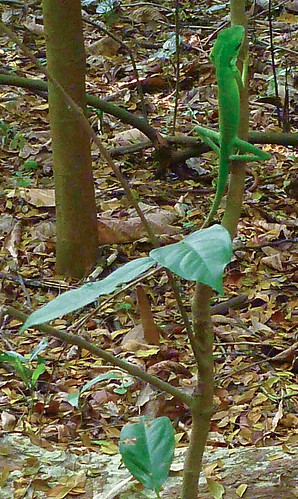
Even before we reached the Visitor Centre, someone had already found a green crested lizard (Bronchocela cristatella).
The large flocks of migratory waders and herons were nowhere to be seen. Birders on the wildbirdSingapore mailing list have mentioned the early arrival of scattered individuals, and we did see a very small group from the Main Hide. Some of these birds include common redshank (Tringa totanus), common greenshank (Tringa nebularia) and common sandpiper (Actitis hypoleucos). I can't wait to see the return of the main wave of migrants in a few months' time.

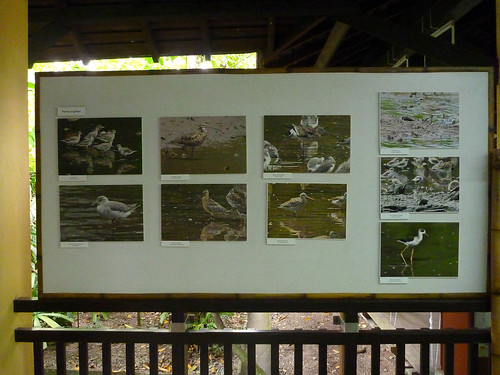
In the meantime, the Visitor Centre had a mini-showcase of some of the wader species photographed in Sungei Buloh.
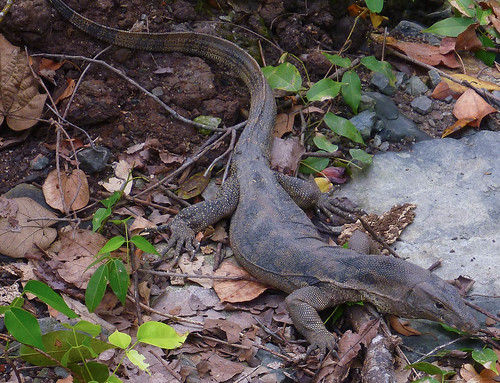
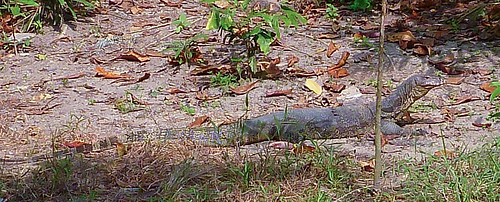
As usual, several Malayan water monitors (Varanus salvator) were spotted over the course of the entire session.
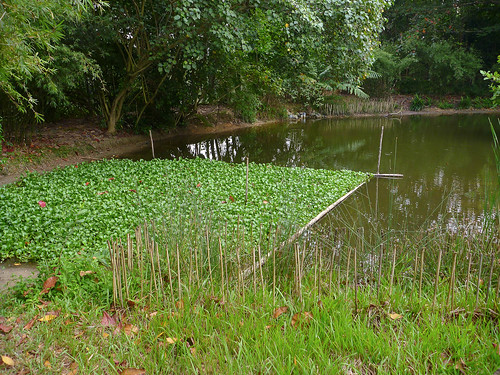
We were keeping an eye out for the smooth otters (Lutrogale perspicillata) that Meryl studied, but alas, they were nowhere to be found.
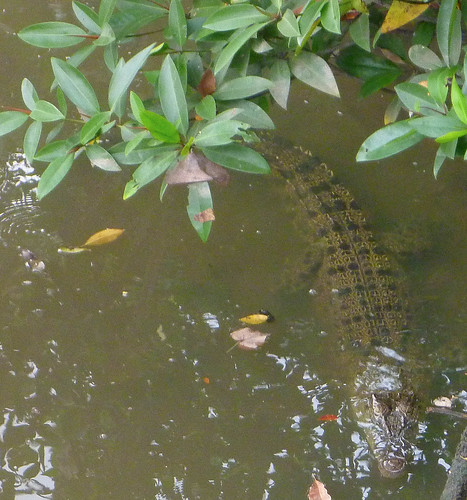
However, an estuarine crocodile (Crocodylus porosus) was seen right below the Main Bridge.
Meryl and I realised that some of the people we were leading probably knew a lot more about various aspects of mangroves than we did; besides, there are larger, more extensive patches of mangroves in some of the scientists' home countries. So we tried a different approach, trying to find out from our group if there were things we had in common.
For instance, the Thai researchers in my group shared how they too consumed the fruit of the nipah palm (Nypa fruticans); while we call it attap chee, in Thailand it is known by some other name. There they are eaten as a dessert with ice-cream. Similarly, the use of the large fronds of this palm to make thatched roofs is widespread throughout communities in Southeast Asia.
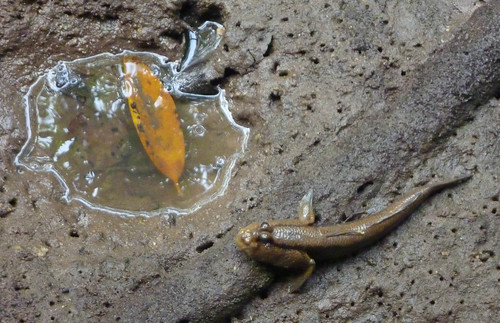
We saw several giant mudskippers (Periophthalmodon schlosseri), as well as other smaller species, including the yellow-spotted mudskipper (Periophthalmus walailakae). This species used to be mistaken for juveniles of the giant mudskipper, until it was determined to be a completely distinct species of mudskipper. Other fishes that we saw included banded archerfish (Toxotes jaculatrix) and striped-nose halfbeak (Zenarchopterus buffonis), as well as several schools of mullet (F. Mugilidae), which were usually detected by the telltale splashes as individual fish leapt out of the water.

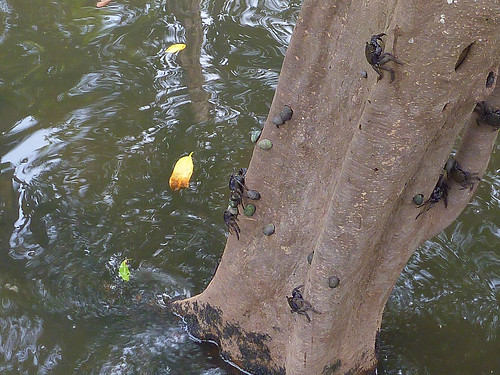

With the tide rising, the tree-climbing crabs (Episesarma spp.) were impossible to miss as they began their ascent.
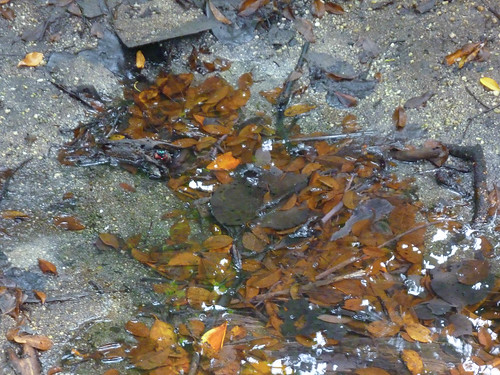
We saw another species of mangrove crab; try to spot the face-banded crab (Perisesarma sp.) in this photo.
Some of the scientists in my group were malacologists; in other words, their area of expertise is in molluscs. They quickly noticed the large lokan (Polymesoda spp.) clams and rodong (Telescopium telescopium) snails on the ground, as well as the lined nerites (Nerita articulata) on the tree trunks. One of them looked closely at the base of a mud lobster mound next to the trail and found 2 other types of snails found in the mangroves.
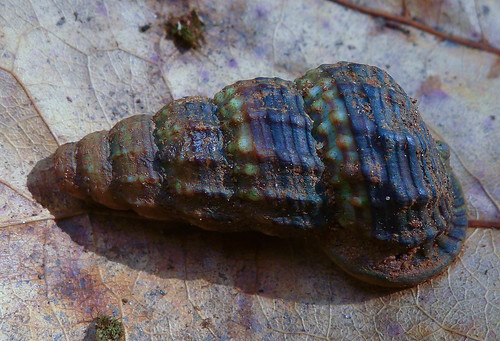
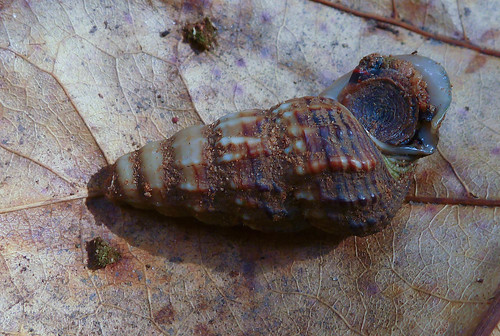
This is a red chut-chut (Cerithidea obtusa). I was sharing how these snails are eaten, with the onomatopoeic local name derived from the smooching sounds made while trying to suck out the flesh from the shell.
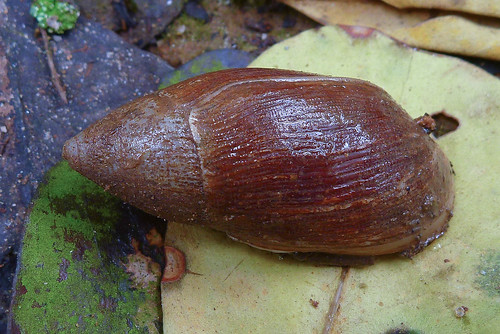
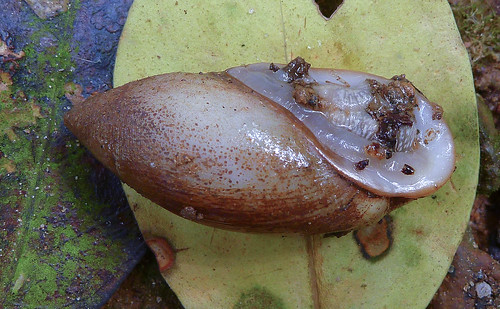
This is a belongkeng (Ellobium aurisjudae).
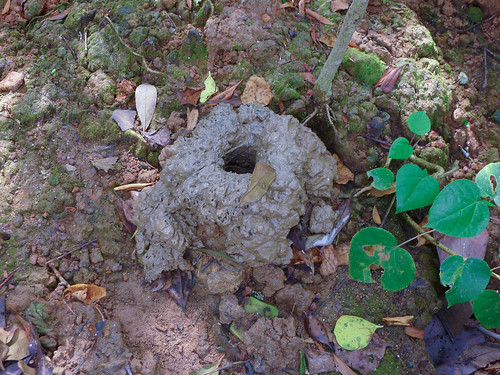
While the carcinologist (one who studies crustaceans) noticed some fresh signs of digging and tunneling at one of the mud lobster (Thalassina anomala) mounds.

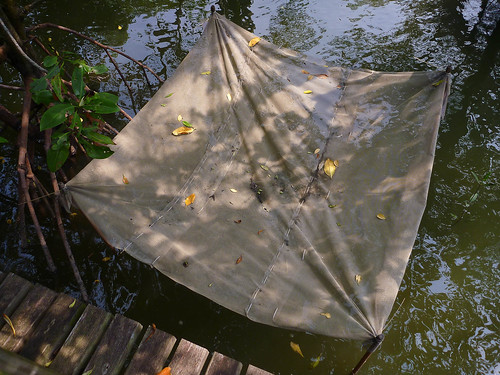
We saw these nets. I believe that these are part of a project by NUS to collect mangrove propagules to study how long they can stay afloat and remain viable. With such data, and knowledge of the currents in the seas around us, we can then see if there is gene flow between different patches of mangrove along the northern coast of Singapore, and whether they also receive propagules from Peninsular Malaysia or even as far afield as Thailand. Dr. Dan Friess shared more about this project in a talk that he gave earlier in May. Our mangroves may be small, but a lot of important research goes on within them, with possible applications for the conservation of mangrove forests elsewhere in the Asia-Pacific!
A trio of plantain squirrels (Callosciurus notatus) amused us with their antics as they chased each other through the trees, and we made our way back to the Visitor Centre, where we were entertained by a white-breasted waterhen (Amaurornis phoenicurus).
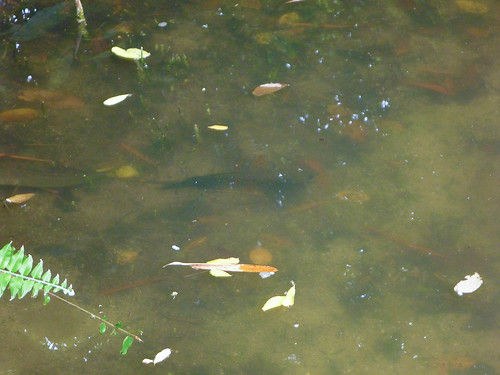
In the freshwater pond at the Visitor Centre, a pair of large common snakehead (Channa striata) were busy guarding their brood. The small red specks over the back of the adult snakehead here are actually a small school of snakehead fry.
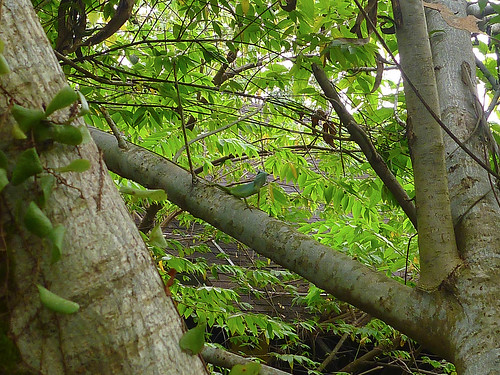
Just as we were leaving, we saw another green crested lizard.
The bus headed back to the RMBR, and en route, Meryl, Jocelyne and I struck up a conversation with Dr. James Reimer, who studies the colonial polyps known as zoanthids. We found out that he'd visited Singapore before, and had explored some of our shores with Ria while studying our own zoanthids. This is the same Dr. Reimer who contributed to a paper about zoanthids in the aquarium trade containing dangerous levels of palytoxin, one of the deadliest toxins known to date. He shared some interesting details about the prevalence of palytoxin in zoanthids; different colonies belonging to the same species in the same general location may have differing levels of the toxin, or some might not even have the toxin at all. So where does the toxin come from? Is it sequestered from some microorganism in the environment? It's a mystery worth looking into.
After lunch, it was time for the next activity. Some of the workshop participants had expressed interest in a guided tour of the Marine Laboratory run by the Tropical Marine Science Institute (TMSI) on St. John's Island. The rest were supposed to go on a guided tour of the museum, led by Jocelyne and me.
However, the scientists who remained around after lunch were so caught up with chats and discussions with colleagues and fellow researchers, while others soon vanished into the museum, keen on looking at specimens pertaining to their areas of interest. Jocelyne and I were left with 3 researchers from Prince of Songkla University, who coincidentally were part of the same group I had guided at Sungei Buloh in the morning.
They had visited the public gallery before, so we led them into the bowels of the museum, down into the collections where most of the specimens were stored.

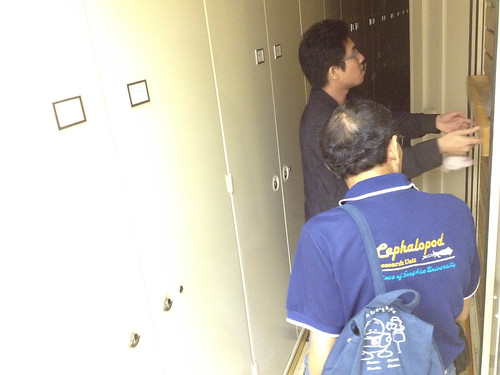
We bumped into David, who was busily cataloguing the huge collection of birds in the dry collection. He took a break from his work to show off some specimens.
One of the trio got "kidnapped" by Professor Peter Ng. Naturally, it was the carcinologist. That left us with just 2 people to guide around the museum, both of whom were malacologists - one studies cephalopods, while the other focuses on gastropods.
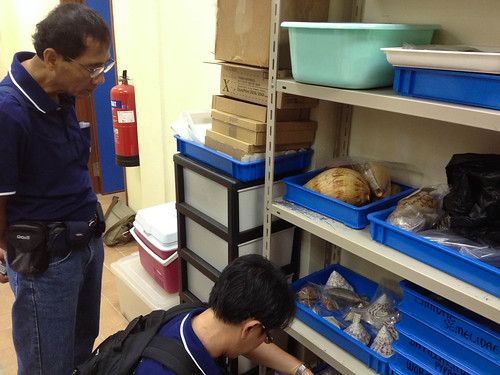
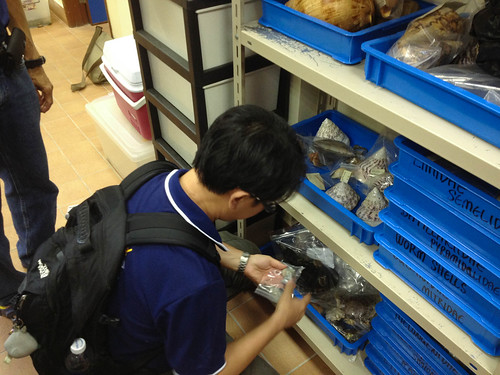
They soon occupied themselves with looking at the many mollusc specimens collected over the years. It was also an excellent opportunity to talk about the constraints that the museum has always faced in terms of storage and exhibition space, hence the move to larger premises in 2014. "Come back in 2 years' time, and you can see dinosaurs too!" we told them.
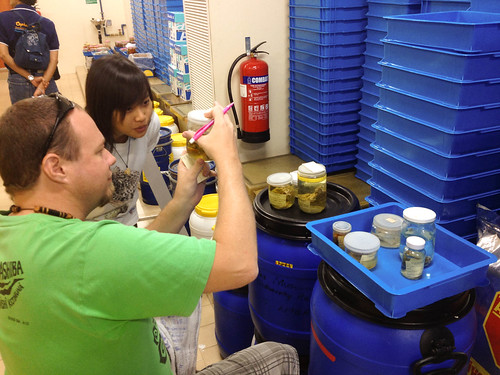
In the wet collections, we found Dr. James, who was already hard at work looking at more zoanthids.
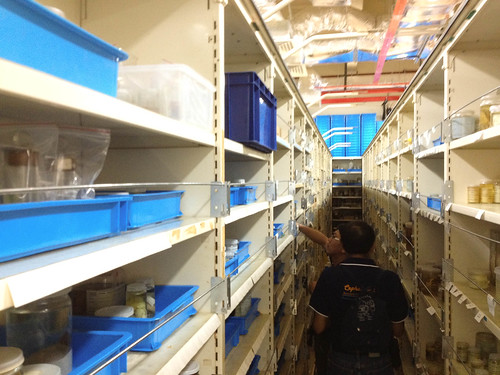
The gastropod specialist (I feel bad for not catching his name) was busily searching for specimens belonging to 2 families of snails he studied, the terrestrial Pupillidae and marine Triphoridae; both families consist of tiny snails, with the former usually being discovered while sifting through soil and leaf litter, and the latter being found feeding on sponges. Alas, both groups were not represented in our collections.
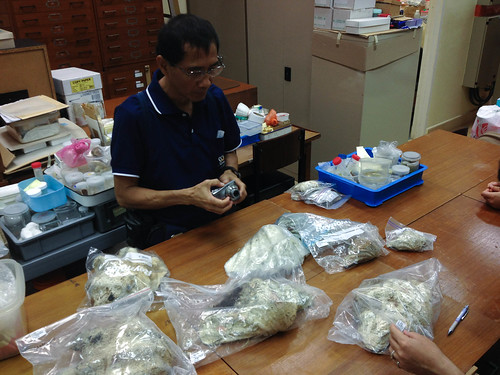
We also found some shells of giant clams (Tridacninae) that had been recovered from our reefs. I shared about our efforts at restoring giant clam populations in Singapore, and also pointed out the sad loss of some of our giant clam species. I also told them about an interesting mystery: the horse's hoof clam (Hippopus hippopus) had supposedly been locally extirpated; certainly, recent surveys failed to turn up any live specimens. However, the intact shell of a large specimen were recovered from Terumbu Raya in 2010. It was thought to have died only recently, but how did it end up here in Singapore, considering that the shell appears to be too large to have been washed here from Indonesia? Did a horse's hoof clam once live on Terumbu Raya and eluded discovery until after it had died?
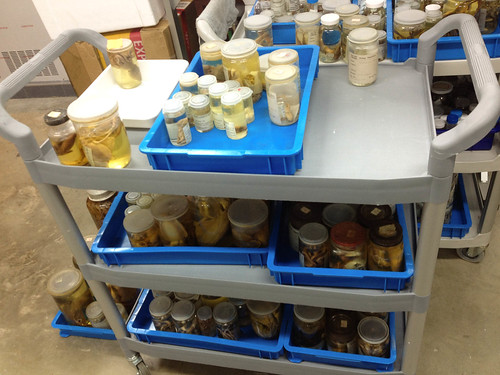
Deeper within the museum, we found a trolley full of cephalopod specimens.
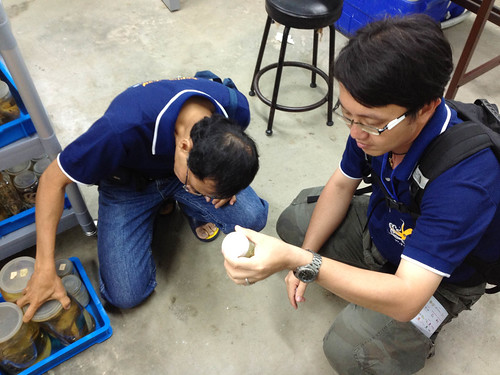
And of course we had lots of fun looking at all the different types of octopus, squids, and cuttlefish.
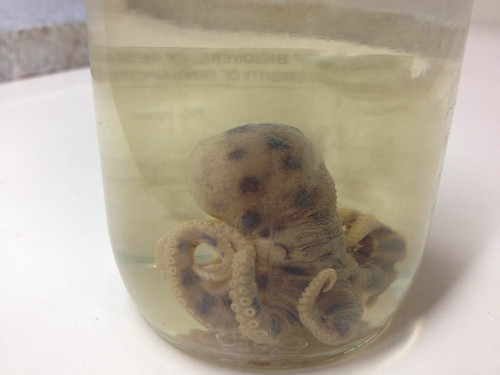
Here's an interesting specimen that they found amongst the jars and bottles. It's a highly venomous blue-ringed octopus (Hapalochlaena sp.) that was apparently collected from Thailand!
Blue-ringed octopus are not limited to Australian waters, but are actually widely distributed across the Indo-Pacific. The taxonomy of the group is still under review, with quite a few supposed undescribed species. And while there haven't been any actual records of blue-ringed octopus in Singapore, a boy died at East Coast Park in 1986 from what was reported back then to be a bite from a blue-ringed octopus. That's quite disconcerting.
And so it wasn't quite the museum tour that Jocelyne and I had expected, although we had a lot of fun showing the scientists around, and learnt quite a lot from them as well. It certainly was an interesting experience, and I'm glad that to have been a part of this cross-cultural exchange of information and knowledge. Every country faces its own challenges and problems regarding biodiversity research and conservation, but some of these are the same, regardless of where you're from; whether it's funding woes, lack of public awareness and support, or simply a lack of resources to comprehensively catalogue the species occurring within national borders. The Thai researchers themselves shared how their own natural history museum had insufficient space.
Studying and protecting marine biodiversity is especially tricky when one is faced with an expanse shared by several nations, like the South China Sea. Being able to accurately assess the biodiversity in the South China Sea and formulate policies for conservation requires collaboration between nations, and a commitment towards upholding and preserving any multilateral agreements over ownership of the resources in the sea. Diplomatic disputes such as those fought over who owns which islands, or the inability to agree to guidelines over shared ownership of marine resources, can seriously impair the progress of scientific research into understanding what lives in the sea and what needs to be done to protect the often fragile habitats within. Hopefully, this workshop has helped to continue to build communication and cooperation, and encourage researchers to build connections with their counterparts elsewhere, so as to improve our collective knowledge and lead to sound decisions for conservation of marine ecosystems. After all, as far as biodiversity is concerned, there are no political boundaries.